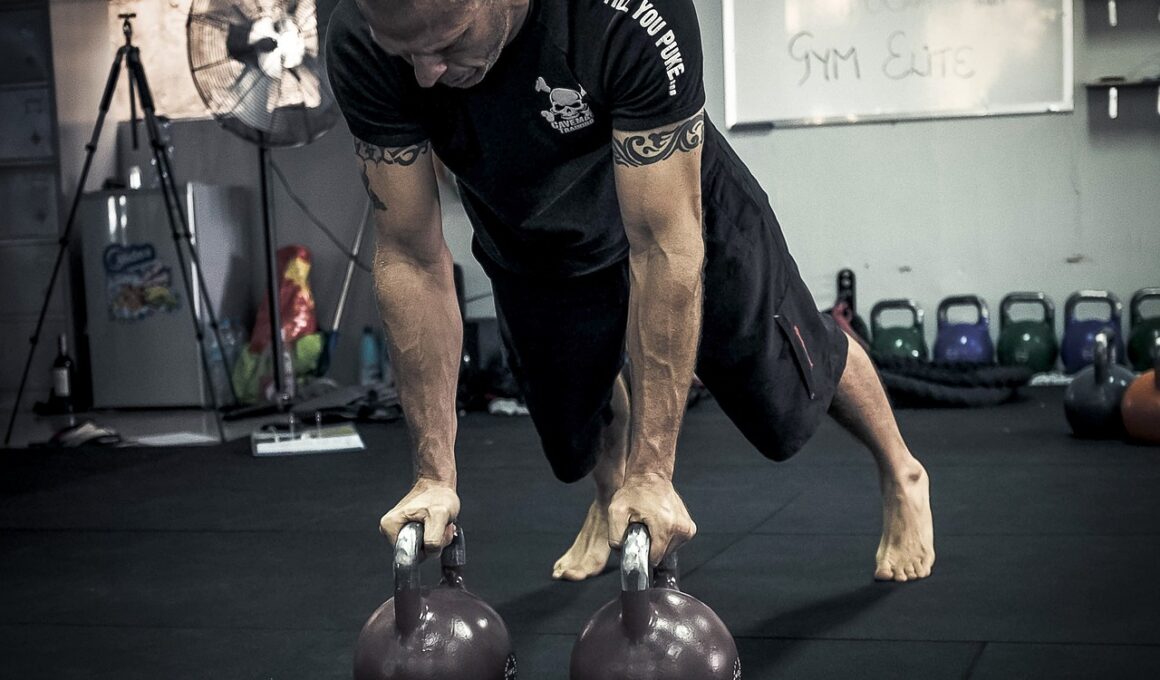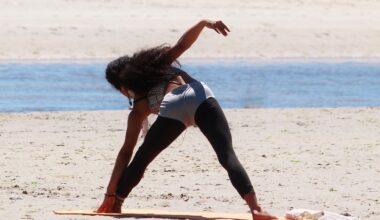Monitoring Mobility and Flexibility Progress in Kettlebell Training
Kettlebell training is not just about building strength; it also involves enhancing mobility and flexibility. Monitoring progress in these areas can lead to more effective workouts and improved overall performance. One effective way to track your mobility and flexibility is by incorporating specific assessments into your routine. Consider using dynamic stretches before a session to gauge your range of motion. Keeping notes on how these stretches improve or vary over time will provide valuable insights into your progress. Don’t forget the importance of recovery routines in maintaining and advancing flexibility. Yoga and stretching sessions act as wonderful complements to kettlebell training, allowing for greater mobility in various exercises. Consider maintaining a diary to help visualize your improvements in flexibility or mobility. Take photographs and write down notes about your performance during sessions. Regular evaluation fosters a deeper understanding of the relationship between flexibility, mobility, and kettlebell exercise effectiveness. Keeping measurements such as the depth of your squat or the height of your swings will provide tangible data to track. Stay dedicated, and your commitment will show noticeable results in your kettlebell training journey.
Setting specific goals for mobility and flexibility is crucial in kettlebell training. Begin by evaluating your current physical limitations and identifying areas you wish to improve. Aim to focus on key movements that align with kettlebell exercises such as the snatch, swing, and Turkish get-up. Assess the specific flexibility needed for each movement to enhance stability and efficiency. For instance, improved hip flexor and hamstring flexibility can significantly influence your kettlebell swing form, thus promoting better results. Consider implementing a few flexibility drills targeting those muscle groups. Furthermore, you could schedule regular assessments every 4 to 6 weeks to objectively evaluate your progress. During each assessment, take note of the range of motion you achieve in various kettlebell movements. Celebrating small milestones will keep you motivated and focused on your ultimate goal. Make sure to integrate variety into your flexibility workouts, including both static and dynamic elements. This blend will prevent monotony and encourage consistent engagement with your mobility training. Engaging your kettlebell routine with a variety of approaches will positively impact your progress.
Incorporating Flexibility Workouts
Incorporating dedicated flexibility workouts into your kettlebell training routine is essential. These focused sessions can effectively enhance your mobility, which directly impacts your kettlebell performance. Allocate specific days or times during the week for flexibility training, dedicating at least 20-30 minutes to these exercises. You can integrate moves such as deep squats, hip openers, and shoulder stretches throughout these sessions to target specific areas that will benefit your kettlebell performance. To maximize results, combine flexibility work with standard kettlebell workouts. This approach promotes muscle recovery while allowing for ongoing mobility enhancement. For instance, pairing kettlebell swings with downward-facing dog stretches can improve shoulder flexibility. Regularly practicing structured flexibility routines will enhance your physical capacity, resulting in increased range of motion and minimized injury risk. Ensure you dedicate time to warm up before diving into your flexibility workouts as well. Warming up prepares the muscles for stretching, making each session more effective. By effectively balancing your kettlebell training with flexibility work, you’ll promote overall physical health and develop valuable muscle control.
Feedback from coaches or experienced kettlebell practitioners can also play a significant role in tracking your progress. Engaging with a knowledgeable trainer can help identify areas for improvement and provide targeted exercises to boost mobility and flexibility. They can offer specific techniques or modifications that suit your individual needs, ensuring you’re maximizing your kettlebell workouts’ benefits. Video recording your sessions can also be a helpful way to assess your ongoing progress. Analyze your movements to identify areas needing improvement, providing a visual reference to review on your own time. Additionally, consider participating in group training sessions or workshops designed to enhance flexibility and mobility specific to kettlebell training. The community environment fosters accountability and encourages shared tips and tactics among participants. This networking can prove invaluable in discovering new exercises or stretches you may not have considered. As you continue tracking your mobility and flexibility improvements, don’t shy away from asking for feedback from fellow practitioners as well. Their input can provide fresh perspectives and encouragement on your journey to achieving your kettlebell training goals.
Consistency is Key
Consistency in tracking your mobility and flexibility progress in kettlebell training truly matters. Designing a schedule that emphasizes your commitment will lead to better performance gains. Establishing a routine allows your body to adapt to the various dynamic movements involved in kettlebell workouts. Maintaining a consistent routine also leads to better habits, which help in sticking to your goals, even when motivation may wane. It is crucial to regularly evaluate your flexibility and mobility routine to identify what works best for you. Reinforce your commitment by setting periodic reminders to reflect on your training regimen. Do not underestimate the power of accountability partners, as working closely with them can inspire consistency. Progress may not always be linear, with plateaus being commonplace in any fitness journey. Patience and perseverance allow for continued growth during these times. Regularly checking in on your results and refining your plan based on your findings will help you maintain progress. Celebrating small victories will also work to boost morale and commitment to your regimen. In the end, consistent evaluations coupled with a disciplined approach lead to impressive advancements.
As you progress through your kettlebell training journey, don’t forget to prioritize self-care and listen to your body. Proper recovery is vital for ensuring optimal performance and preventing injuries associated with flexibility and mobility training. Incorporate rest days to allow your body to heal and recharge, especially after intense workout sessions. With kettlebell training’s demanding nature, fostering a recovery plan can ensure sustained gains in flexibility and mobility. Techniques such as foam rolling, massage, and proper hydration contribute to quicker recovery and improved muscle functionality. Additionally, maintaining a balanced diet plays a crucial role in enhancing your training and flexibility efforts. Consuming nutrients that support muscle recovery and growth will enable more significant progress in your kettlebell training. Remember, adequate nutrition can also influence your overall energy levels and mood, which affects your consistency. Practicing mindfulness techniques, such as meditation, may further improve your focus and aid recovery. A holistic approach that combines physical activity, nutrition, and mental health will ultimately lead to a more enriching kettlebell experience.
Conclusion
In conclusion, monitoring mobility and flexibility progress in kettlebell training is critical for optimizing performance and minimizing injuries. Using specific assessments and setting clear goals ensures you remain focused and motivated. Incorporating flexibility workouts alongside kettlebell routines is essential for achieving the best results and allows for a more favorable training regimen. Engage with coaches and peers to gain perspectives and insights, enhancing your training experience. Stay committed to your journey by maintaining consistency and prioritizing self-care practices. Remember, progress takes time, and dedication yields rewarding results. Reflect on your achievements regularly to reinforce your motivation and commitment to your kettlebell training journey. By employing these techniques, you will master kettlebell training while enhancing flexibility and mobility. As a result, you will experience an overall improvement in your fitness level and well-being. Continue exploring new flexibility exercises, tracking techniques, and resources that inspire training enhancements. Let the journey be as enjoyable as the results, and embrace the transformation that kettlebell training can achieve for you.


